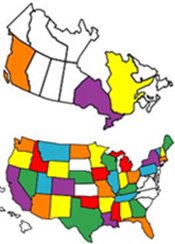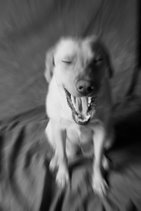skip to main |
skip to sidebar
When I first got my T@B, I struggled trying to decide on the best solution to recharging the battery (which usually lasts about 2 days) when dry camping. Getting a small gas-powered generator was the most obvious choice, but I really didn't want to deal with hauling a filled gas can around or the mess of changing oil, etc (not to mention the mood-killer of listening and smelling a gas engine running when trying to enjoy the great outdoors).
So the more eco-friendly choice was to get a solar panel. It's certainly on my list one day, however, dry camping in the Northwoods doesn't always guarantee sufficient sunshine--- what would I do if I needed to recharge my battery on a cloudy day?
Well leave it to one of my fellow ingenious T@B buddies, Jay, to come up with a brilliantly simple alternative solution (and another T@B buddy, Jeremy, to perfect the idea even further). Jay and his wife often like to go sightseeing once they've set up camp, so Jay's idea was to bring a 2nd battery along and hook it up to his truck's 7-pin connector so that while they were out driving around, the spare battery would be getting charged up.
But that was only half of the brilliant solution! When they returned to camp, rather than have to fool with unhooking the T@B's battery and swapping it with the spare, Jay realized he could simply connect the spare battery to the T@B using the T@B's 7-pin connector cable.
Jeremy took this idea one step further and installed a "car-end" 7-pin connector directly into the spare's battery box so that you wouldn't even need to swap out a "car end" connector when attaching to the T@B for a "trailer end" connector when recharging the battery from the tow vehicle.
I wasn't quite as handy as Jeremy, so I just created a car-end connector cable to always keep attached to the spare battery. The battery, by the way, is an AGM self-contained model so that it's safe to carry around in the back of my enclosed station wagon.
Here are the components:
1. Make a cable with 2 "trailer end" 7-pin connectors. Inside the black cable cover are (2) 12 gauge wires to connect the 12v power and ground connections of the 7-pin.
 2. Make a cable with 1 "car end" 7-pin connector (also used two 12 gauge wires to connect the 12v power and ground connections).
2. Make a cable with 1 "car end" 7-pin connector (also used two 12 gauge wires to connect the 12v power and ground connections). 3. Connect the "car end" cable to the spare battery. In this setup, you can now connect it to the T@B's 7-pin connector cable to provide 12 volt power to the T@B.
3. Connect the "car end" cable to the spare battery. In this setup, you can now connect it to the T@B's 7-pin connector cable to provide 12 volt power to the T@B. 4. Use the "trailer to trailer" cable to recharge the battery (My tow vehicle's 7-pin connector is on a cable itself that I can keep completely inside the car when not towing).
4. Use the "trailer to trailer" cable to recharge the battery (My tow vehicle's 7-pin connector is on a cable itself that I can keep completely inside the car when not towing).
T@Bs are small trailers, so full-sized home appliances, or even full-sized RV appliances are usually too big and waste too much precious storage space in the T@B. The LP furnace that is an optional accessory for the T@B is one such "space-waster". In the clamshell or L models, the furnace takes up minimal space because it's a straight shot from the external air supply/vent to the front of the unit. But on the queen bed model T@Bs, the front of the furnace is actually beneath one of the rear seats, so the factory must install extra vent tubes to route the air and exhaust out properly. These tubes take up most of one side of the under-seat rear storage, and even 1/3rd of the other rear seat storage as well. That's a ton of storage space to give up!
My first T@B didn't come with an LP furnace, so I was forced to improvise. What I discovered was that I actually liked the alternatives better than the real thing! And, I certainly liked having all that rear seat storage fully available.When I am at a campground with electric hook-ups, I use a $30 oscillating ceramic heater that I purchased from Home Depot. It's small, lightweight, quiet, and heats the T@B very quickly. It also has a built-in thermostat and adjustable fan speeds. A great deal!
When I'm away from electric and dry camping ("boondocking"), I use an Olympian Wave 3 catalytic heater. It runs off of LP gas, is TOTALLY silent, and unlike the LP furnace, does not require any battery power to run. It's also very small and lightweight and uses less LP gas than the furnace.
In my first T@B, I installed a brass T-connector on the gas line outside coming from the LP tank and then ran an LP hose up through the front window to connect to the Olympian heater (which sat on the front kitchen countertop). While this required no major modifications to the T@B, it required that the heater be placed at a higher level than was best (heat rises). So, in the new T@B, I had my dealer install the T connector underneath the stove on the inside of the T@B. I also got a quick connect fitting so that I would not need to use wrenches to attach and disconnect the hose to the heater each time.When not in use, the hose and quick connect wraps nicely into the under-stove cabinet.
 When I want to hook up the Olympian, I just unwrap the hose and connect it. I can place the heater on the floor if I keep the couch in "couch mode", or else place it on a table or on top of the stove itself if I extend the bed out fully.
When I want to hook up the Olympian, I just unwrap the hose and connect it. I can place the heater on the floor if I keep the couch in "couch mode", or else place it on a table or on top of the stove itself if I extend the bed out fully.


Here are a few odds and ends that make life more comfortable with the T@B.
First, these simple stainless steel over-the-door hooks from Bed, Bath & Beyond are terrific for use for hanging coats, towels, toiletry bags, pot holders and other items. They're less than $5 each and well worth it!
 The T@B has a limited amount of cargo capacity, so while you physically might be able to load up the trailer with tons of stuff, the frame itself is not rated to carry that much weight. So, as a consequence, you need to always be looking for the lightest weight solutions for every item you carry in the T@B. I bought a set of lightweight Bugaboo cooking pots and Lexan unbreakable plastic dishware from REI. The mesh storage bags also make them easy to store.
The T@B has a limited amount of cargo capacity, so while you physically might be able to load up the trailer with tons of stuff, the frame itself is not rated to carry that much weight. So, as a consequence, you need to always be looking for the lightest weight solutions for every item you carry in the T@B. I bought a set of lightweight Bugaboo cooking pots and Lexan unbreakable plastic dishware from REI. The mesh storage bags also make them easy to store. The pots use a removable grip handle and the skillets do double duty as lids to the larger pots.
The pots use a removable grip handle and the skillets do double duty as lids to the larger pots. Interiors of the pots are all Teflon coated.
Interiors of the pots are all Teflon coated. The Lexan dishes and cups are stored inside it's own salad bowl and meat platter.
The Lexan dishes and cups are stored inside it's own salad bowl and meat platter. The kit also includes 4 cups, plates, and bowls.
The kit also includes 4 cups, plates, and bowls. This space-saving folding lug wrench is great and easily opens to a full sized version.
This space-saving folding lug wrench is great and easily opens to a full sized version.
 Finally, to avoid buying/transporting lots of those 1 lb propane bottles, I bought this LP hose which connects a large propane cylinder to outdoor LP appliances (such as my LP Grill).
Finally, to avoid buying/transporting lots of those 1 lb propane bottles, I bought this LP hose which connects a large propane cylinder to outdoor LP appliances (such as my LP Grill).
Well, if Mom, Millie and I didn't have enough of an adventure last summer in the Rockies (coming home car-less and T@B-less), we're planning to tempt the Gods again and take another big adventure this year too! We're planning to do the Pacific Northwest in May and June.
To get T@Bitu a bit more comfortable and functional for the trip, I've been making a few modifications lately--First, I moved the spare tire from underneath the T@B (impossible to access) to a tongue-mounted carrier (slightly easier access).

 Next, I removed the heavy, large folding T@B table, and replaced it with a lightweight, small TV tray for daytime use, and some wooden "bed slats" for nighttime use to support the queen bed. Not only are the bed slats about 25 lbs lighter than the T@B table, they also allow more open space beneath the slats to store extra cargo. This is by far, the best $20 mod you can ever make to your T@B! Thanks to California Al from the Yahoo T@B Owners' Forum for the suggestion!
Next, I removed the heavy, large folding T@B table, and replaced it with a lightweight, small TV tray for daytime use, and some wooden "bed slats" for nighttime use to support the queen bed. Not only are the bed slats about 25 lbs lighter than the T@B table, they also allow more open space beneath the slats to store extra cargo. This is by far, the best $20 mod you can ever make to your T@B! Thanks to California Al from the Yahoo T@B Owners' Forum for the suggestion!



 Next, I reinstalled the screen door from my old T@B into this one. However, rather than installing it the same way the factory does (where it opens towards the couch), I removed and reversed the snap tabs so that the door now opens towards the fridge for a bit less claustrophobic feel when you enter and exit the T@B.
Next, I reinstalled the screen door from my old T@B into this one. However, rather than installing it the same way the factory does (where it opens towards the couch), I removed and reversed the snap tabs so that the door now opens towards the fridge for a bit less claustrophobic feel when you enter and exit the T@B.

 Finally, to make our 6,000 mile trip as smooth as possible, I bought a pair of shocks from Jeremy on the Yahoo T@B Owners' Forum and had my dealer install them for me. The T@B now tows more quietly and smoothly-- what a nice ride!
Finally, to make our 6,000 mile trip as smooth as possible, I bought a pair of shocks from Jeremy on the Yahoo T@B Owners' Forum and had my dealer install them for me. The T@B now tows more quietly and smoothly-- what a nice ride!




















































